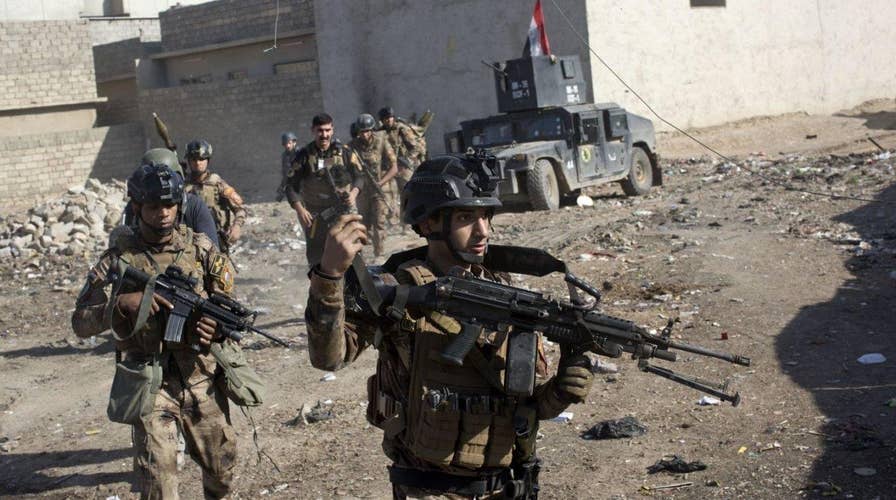MOSUL, Iraq – Iraq's special forces worked Sunday to fully clear neighborhoods on Mosul's eastern edge of Islamic State (ISIS) militants as suspected ISIS bombings killed at least 20 people elsewhere around the country.
The current phase and slower pace highlight the challenges ahead for Iraqi forces as they press into more populated areas deeper inside Mosul -- where the civilian presence means they won't be able to rely as much on airstrikes.
"There are a lot of civilians and we are trying to protect them," said Lt. Col. Muhanad al-Timimi. "This is one of the hardest battles that we've faced till now."
Some civilians are fleeing the combat zone, while ISIS militants are holding others back for use as human shields, making it harder for Iraqi commanders on the ground to get approval for requests for U.S.-led coalition air strikes. Iraq's special forces are some of the country's best troops, but they still largely rely on air support to clear terrain.
Iraqi forces first entered the eastern edge of the city on Tuesday. On Friday, forces began pushing into Mosul proper, but so far have only advanced just over a mile into the city. On the city's southern front Iraqi forces are still some 12 miles from the city center.
The extremists captured the city in 2014, and have had plenty of time to erect fortifications. Trenches and berms have turned the streets and alleyways of a neighborhood once named after former Iraqi leader Saddam Hussein into a maze, and concrete blast walls have blocked off access to other areas.
"Daesh dug trenches that they filled with water and they have a lot of suicide attackers and car bombs," said al-Timimi, using the Arabic acronym for the ISIS group.
ISIS fought back Saturday, pushing the special forces from the southern edge of the Gogjali neighborhood, where the troops had made their first major foray into the city itself after more than two weeks of fighting in its rural outskirts.
Both sides fired mortar rounds and automatic weapons, while the Iraqi troops also responded with artillery. Snipers dueled from rooftops in residential areas, where most buildings are just two stories high.
Meanwhile suspected ISIS militants struck far from the front lines with a pair of bombings that killed at least 20 people. One suicide attack against Shiite pilgrims north of Baghdad killed at least 11 people.
The spokesman for Salahuddin province, Ali al-Hamdani, said the deadliest attack took place in the city of Samarra, 60 miles north of Baghdad, where a revered Shiite shrine is located.
Al-Hamdani said the bomber parked his explosives-laden ambulance in a parking lot and walked up to the pilgrims who had just left their busses and were heading to the shrine about 500 meters away. He first detonated the car and then blew up himself.
He added that at least four Iranians were among the dead. Up to 100 others were wounded, he said.
Another suicide attacker rammed an explosives-laden car during rush hour Sunday morning into a checkpoint outside the Salahuddin provincial capital, Tikrit, killing at least nine people.
Al-Hamdani said five female students, a woman and three policemen were killed in the attack, while 25 others were wounded.
No group has claimed responsibility for the attacks, but they bore the hallmarks of ISIS, which has conducted and claimed dozens of similar bombings.
In April 2015, Iraqi security forces drove out ISIS militants from Tikrit, about 80 miles north of Baghdad.

